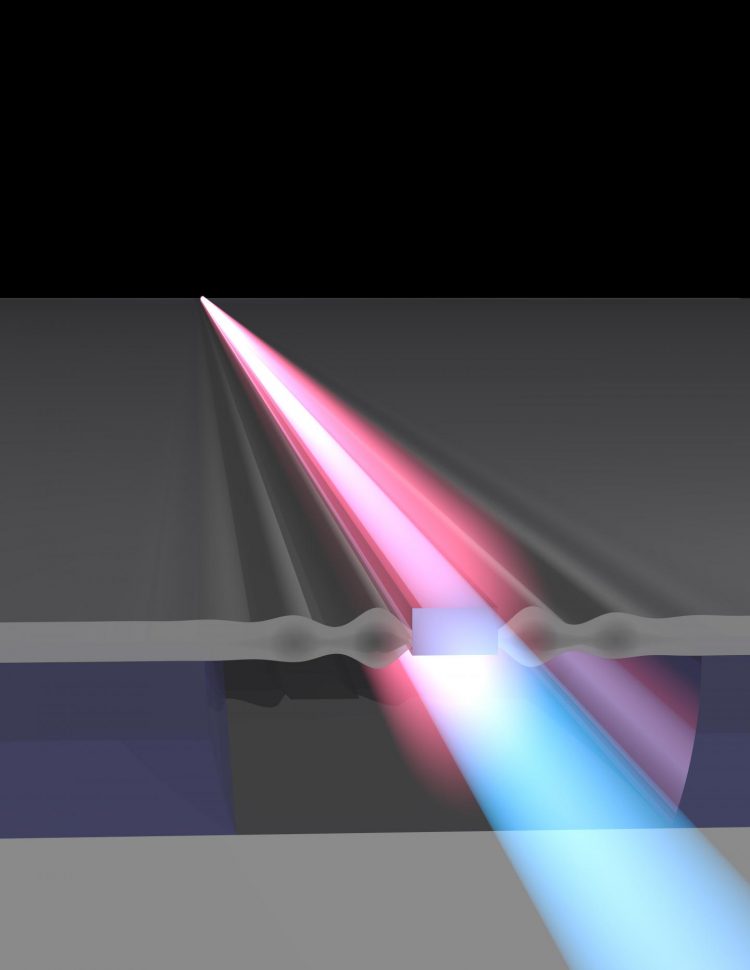Yale scientists amplify light using sound on a silicon chip

Yale scientists have found a way to amplify the intensity of light waves on a silicon microchip. Credit: Yale University
Writing in the journal Nature Photonics, a team led by Peter Rakich describes a new waveguide system that harnesses the ability to precisely control the interaction of light and sound waves. This work solves a long-standing problem of how to utilize this interaction in a robust manner on a silicon chip as the basis for powerful new signal-processing technologies.
The prevalence of silicon chips in today's technology makes the new system particularly advantageous, the researchers note. “Silicon is the basis for practically all microchip technologies,” said Rakich, who is an assistant professor of applied physics and physics at Yale. “The ability to combine both light and sound in silicon permits us to control and process information in new ways that weren't otherwise possible.”
Rakich said combining the two capabilities “is like giving a UPS driver an amphibious vehicle — you can find a much more efficient route for delivery when traveling by land or water.”
These opportunities have motivated numerous groups around the world to explore such hybrid technologies on a silicon chip. However, progress was stifled because those devices weren't efficient enough for practical applications. The Yale group lifted this roadblock using new device designs that prevent light and sound from escaping the circuits.
“Figuring out how to shape this interaction without losing amplification was the real challenge,” said Eric Kittlaus, a graduate student in Rakich's lab and the study's first author. “With precise control over the light-sound interaction, we will be able to create devices with immediate practical uses, including new types of lasers.”
The researchers said there are commercial applications for the technology in a number of areas, including fiber-optic communications and signal processing. The system is part of a larger body of research the Rakich lab has conducted for the past five years, focused on designing new microchip technologies for light.
Heedeuk Shin, a former member of the Rakich lab who is now a professor at the Pohang University of Science and Technology in Korea, is the study's other co-author. “We're glad to help advance these new technologies, and are very excited to see what the future holds,” Shin said.
###
The work was supported by the MesoDynamic Architectures program at the U.S. Department of Defense's Defense Advanced Research Projects Agency (DARPA).
Media Contact
All latest news from the category: Physics and Astronomy
This area deals with the fundamental laws and building blocks of nature and how they interact, the properties and the behavior of matter, and research into space and time and their structures.
innovations-report provides in-depth reports and articles on subjects such as astrophysics, laser technologies, nuclear, quantum, particle and solid-state physics, nanotechnologies, planetary research and findings (Mars, Venus) and developments related to the Hubble Telescope.
Newest articles

NASA: Mystery of life’s handedness deepens
The mystery of why life uses molecules with specific orientations has deepened with a NASA-funded discovery that RNA — a key molecule thought to have potentially held the instructions for…

What are the effects of historic lithium mining on water quality?
Study reveals low levels of common contaminants but high levels of other elements in waters associated with an abandoned lithium mine. Lithium ore and mining waste from a historic lithium…

Quantum-inspired design boosts efficiency of heat-to-electricity conversion
Rice engineers take unconventional route to improving thermophotovoltaic systems. Researchers at Rice University have found a new way to improve a key element of thermophotovoltaic (TPV) systems, which convert heat…



